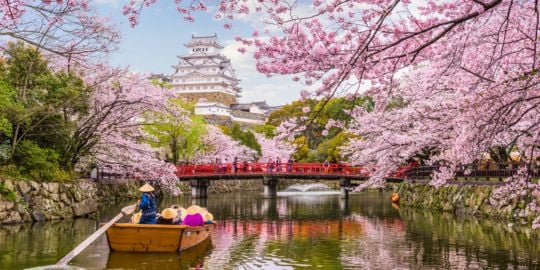Finding a job in Saitama

Tokyo's quieter neighboring city has everything to offer. Saitama, north of Japan's capital, is an attractive, dynamic region with a strong forward-looking focus. So, if you want to work in Saitama, follow the guide.
Mapping Saitama
Location
Saitama is, first of all, a prefecture with 7.337 million inhabitants in 2022. Most of them live in the capital city (1,344,875 inhabitants by December 2023), which bears the same name as the prefecture, while other major cities in the prefecture, Kawaguchi, Kawagoe, Tokorozawa, and Koshigaya, have populations ranging from about 605,000 to 343,000.
Metropolitan Tokyo borders the Saitama Prefecture to the south, the Yamanashi Prefecture to the southwest, Nagano to the west, Gunma to the north, and Ibaraki to the east.
Saitama City
Saitama's capital city has ten wards called "ku"s in Japanese: Chûô-ku, the central district, Iwatsuki-ku, Kita-ku, the northern district, Midori-ku, Minami-ku, the southern district, Minuma-ku, Nishi-ku, the western district, Omiya-ku, Sakura-ku, and Urawa-ku.
Not surprisingly, the most populated ward is the southern one, Minami, with a population of 194,319 people by December 2023. This is understandable, given the ward's proximity to Tokyo. The Urawa ward is the next most populous, with about 170,000 people.
In Saitama, 40–49-year-olds are the most numerous, with 401,255 inhabitants, ahead of the 20–39-year-old segment that counts 322,489 people. There are 281,288 people aged between 60 and 79 years old, and 231,811 people are between 0 and 19 years old. These are encouraging figures for a country with a meager birth rate. In Saitama, both in the prefecture and the city, the population has steadily increased since the 1990s.
Saitama City, the economic heart of Saitama Prefecture
Saitama was founded in 2001, thanks to the fusion of former cities Urawa, Omiya, and Yono. A year later, Iwatsuki City joined the merger, further expanding Saitama's global influence. The goal was to build a new city to become the prefecture's economic and social hub, resulting in the "Saitama Shintoshin", which means Saitama New Urban Center.
Designed as a cocoon, the city's new downtown boasts its futuristic architecture, modern sports and art complexes, and shops and gardens. In time, the city's administrative offices will move to Saitama Shintoshin. As such, significant economic development is around the corner suggesting good career prospects for expatriates.
Saitama's key sectors
The economic pillars of the prefecture
The prefecture has three primary economic mainstays: the agri-food, aerospace and automotive industries, and medical sector. These sectors have leveraged Saitama's strategic location to thrive.
Regarding the food industry, the prefecture ranks second in the country in terms of product shipment and first in the country regarding value-added products. The market is mainly driven by three giants: Saitama Kikkoman, known worldwide for its soy sauces; Glico Manufacturing Japan, famous for its Pocky cookies, and Nakamuraya, a significant producer of curry, curry sauce, pasta sauce, etc.
The capital? An R&D hub!
If you have skills in optics, consider settling down in Saitama City. TAMRON, Fujifilm Corporation Omiya Office, and Sumita Optical Glass are among the significant optical companies in Saitama.
The city, which defines itself as an R&D hub, has launched its "Saitama Initiative for Medical Monozukuri" to attract even more medical, device, and equipment manufacturers. This is how Atom Medical Group, Asahi Rubber, and Shin-Etsu Polymer have made the capital city their home.
Moreover, Saitama has also introduced its label, "Saitama City Leading-edge Competition Certification and Support Program", which grants certification to manufacturers that invest in R&D. This program also enables companies in Saitama to compete more effectively in the international market.
SME support
The scheme is called "SPIC", which stands for "Saitama Industrial Promotion Public Corporation". Introduced by the Saitama Prefecture, the SPIC scheme provides active support to over 200,000 small and medium-sized enterprises (SMEs).
Its primary mission is to develop Saitama's industry, make it competitive, and attract local and international talent, thereby contributing to the economic health of the region and the country.
SPIC advises small and medium-sized companies not only on management and business development in Japan and abroad but also on relations with other professionals (B2B), intellectual property, new technologies, and human resources.
Working in Saitama
A constantly developing city
Since its establishment in 2001, Saitama City has kept growing. In 2004, it launched the "Saitama Hopeful City Plan". This plan continues to be updated to reflect the socioeconomic and cultural evolution of the city. Its latest version incorporates changes driving the post-COVID world and aims to provide an environmentally friendly living and working space where everyone can thrive.
A forward-looking city
The city is restructuring its urban spaces to attract new residents, with a better balance between economic centers (more numerous and better distributed) and nature. As for work, and in response to the COVID-19 crisis, Saitama is encouraging remote work and more flexible work organization.
Aware that its population is likely to decrease slowly, with a peak expected in 2030, Saitama wants to take advantage of the changes due to the health crisis to promote a new vision of work, cope with an aging population, and attract new local and international workers.
A multicultural city
"Diversity and cooperation among all citizens, regardless of origins". This is the Saitama Hopeful City Plan 2030's motto to support its policy of welcoming people from all walks of life. The economic sector is not the only area of focus. Sports and culture are also part of the plan to revitalize the capital by strengthening community interactions.
In 1987, the prefecture created the Saitama International Association (SIA). The SIA is multilingual and assists foreign residents in all aspects of their daily lives, including moving in, school and university registration, and job search.
At the same time, the city of Saitama has set up many assistance and consultation services, such as the International Exchange Center and the Saitama Information and Support.
Benefits of working in Saitama
“Easy to live in”. This is how Saitama Prefecture is described.
Despite the COVID crisis, Saitama's economy has remained resilient. It is part of the prefecture's strong points, which include regions with a strong character where nature has its place and the proximity to Tokyo. And it is a fact! More and more inhabitants are choosing to live in Saitama while continuing to work in Tokyo.
Others are taking advantage of the booming teleworking industry and have stopped commuting daily between the two cities to work or study. Now, they mostly stay in Saitama.
In other words, the Saitama prefecture is a region where it is good to live, especially since the cost of living is cheaper than in Tokyo. You can find more spacious and less expensive housing in Saitama than in the capital, Tokyo.
You can settle in the countryside, in friendly places like Yokoze, Chichibu, Minano or Nagatoro. The popularity of Chichibu and Nagatoro has spilled beyond the prefecture's borders and even Japan's. Parallelly, the touristy city of Kawagoe is winning the hearts of local and foreign tourists.
Others might prefer the capital city of Saitama and its urbanism, but at the end of the day, Saitama Prefecture has a place of peace to offer to everyone.
Finding a job in Saitama
It all depends on what you are looking for. The COVID crisis has disrupted the working world, and Saitama is no exception. During the early days of the health crisis, finding a job in Saitama, including a small job, “baito” in Japanese, was challenging since most businesses faced traumatic difficulties.
However, business conditions in Saitama City have shown a moderate recovery after the pandemic, and many believe that the outlook will remain strong.
The DI for business conditions in Saitama City for the second quarter in 2023 (April–June 2023) was −16.5 points, an increase of 1.9 points compared to the same period last year (April–June 2022) when it was −18.4 points. This indicates an improvement from the previous year (source: https://www.city.saitama.lg.jp/006/014/008/003/012/006/p099070_d/fil/2023zennki_gaiyou.pdf).
So, numerous job prospects await you; naturally, it's essential to be mentally prepared for the intense competition.
Small jobs
One can find small job ads posted in local shops and specialized magazines at the train station, subway stations, or on the Internet. Otherwise, you may browse among many search sites in Japanese, such as Nihon de "baito" (only available in Japan) and Baitoru, or other sites in English, like Craigslist, and dedicated community platforms, like Expat.com.
The open-ended contract
Patience and determination are the keywords here. A permanent or open-ended contract is the first step toward a work visa in Japan. Remember that the company sponsoring you is making a "heavier" investment than if it were hiring a permanent resident or a local. It has to deal with Japanese immigration and engage in a costly, time-consuming process.
So, put all the chances on your side by building a solid profile. Japan is an elitist country, and knowing that, you should keep upgrading your level of Japanese, publish your diplomas, and show work experience. If you come from a world-famous university, put it forward. Otherwise, bet on your experience, especially if you have worked in well-known companies in Japan.
For more chances of finding a job in Saitama, contact the Saitama Chamber of Commerce and Industry (CCI). You should also check with other chambers of commerce and industry. Use your address book. Join professional associations and informal groups. Subscribe to Japanese professional social networks such as Wantedly.
Tips for living and working in Saitama
Be aware of the new recruitment methods in Japan. There is no longer a need for a personalized CV but rather a standard application form with a mandatory photo. The Western-styled CV is gaining ground, especially among major groups. However, it is highly advisable to master the Japanese CV and train yourself to fill it out by hand. No typing, neither for the CV nor for the cover letter. This will help you revise your kanji.
Keep a few hours during the week to review your Japanese lessons, especially if you know your weaknesses. Some companies will ask you to pass the international Japanese Language Proficiency Test (JLPT) level 2, the advanced intermediate level. However, other companies may require level 1, the bilingual level.
Take the time to scout throughout Saitama Prefecture. The region is not limited to its capital city and has multiple aspects that wait to be experienced. In the far North, there is Honjô, named after the Honjô clan, which ruled the area during the Kamakura era in the 12th century. In the West, Mount Ryôkami is one of the 100 most beautiful mountains in Japan.
Between two job search sessions, recharge your batteries amidst a soothing nature. The advice may seem strange, as the job search is crucial to ensure a good life in Japan, but it is essential to keep your morale up. Of course, there is no need to spend your money on a trip to the far end of the prefecture. A trip to the local park will be enough. Believe in yourself and be patient. Your new life in Japan is just beginning.
Useful links:
Saitama Prefecture (in Japanese, multilingual translation)
Saitama International Association (SIA)
Saitama Chamber of Commerce and Industry (in Japanese)
Nakamuraya (in Japanese)
Saitama Industrial Promotion Public Corporation









